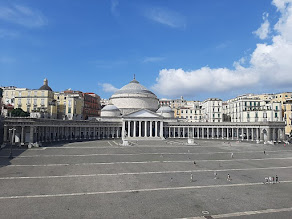Castrato taught Lord Nelson’s lover
 |
| Giuseppe Millico was for a while a celebrated and in-demand castrato singer |
As a singer, Millico is best remembered for his performances in the operas of the Bavarian composer Christoph Willibald Gluck. He also compiled a significant body of work of his own, including eight operas, eight cantatas, numerous arias and duets not part of wider works, and 82 canzonets.
Having learned his craft in Naples in the 1750s, Millico returned to the city in 1780 after many years of touring, becoming a teacher as well as a composer. He taught singing to the Bourbon princesses Maria Teresa and Luisa Maria, as well as to Emma, Lady Hamilton, the actress and model, who was living in Naples after her marriage to Sir William Hamilton, the British Ambassador.
After studying at one of the Naples conservatories, Millico made his performing debut in Rome in 1757. Soon afterwards, he went to Moscow to sing at the Russian court. He remained in Russia for seven years, earning the nickname Il Moscovita on his return.
His links with Gluck began in 1769 in Parma, Gluck was preparing a great celebratory work, Le feste d’Apollo, for the marriage of the Bourbon Duke Ferdinand of Parma and Maria Amalia of Austria. The work incorporated part of his opera Orfeo ed Euridice, which Gluck adapted to suit voice of Millico in the role of Orfeo. The following year, Gluck rewrote the whole of the opera with Millico in mind and invited him to play Orfeo in Vienna. He similarly adapted his opera Alceste and wrote a new work, Paride ed Elena, specifically for him.
 |
| One of the many paintings of Emma Hamilton by the English portrait painter, George Romney |
While he was based in London, Millico travelled extensively, singing in Paris and at several opera houses in Germany, including Mannheim, Schwetzingen and Zweibrücken. He toured the major opera centres in Italy – Venice, Milan, Florence and Rome before returning to Naples.
Some time after 1777, he was appointed Virtuoso di Camera e della Regia Cappella - Virtuoso of the Chamber and Royal Chapel - in Naples, and music master to the Royal princesses, Maria Teresa and Luisa Maria.
It was not long before he had given up performing as a singer in order to dedicated himself to composing and teaching.
His operas included Le cinesi and L’isola disabitata, written for the Bourbon princesses. He wrote two operas to libretti by Pietro Metastasio and one to words by Ranieri de' Calzabigi, who had been Gluck's librettist. His work La pietà d’amore, commissioned by Antonio Lucchesi-Palli, Prince of Campofranco in Sicily, was interpreted as a message of support for Gluck.
Millico came into contact Emma Hamilton, who was married to Sir William Hamilton in 1791, having become his lover in Naples, probably through Queen Maria Carolina, sister of Marie Antoinette and wife of Ferdinand I of Naples, with whom she developed a friendship.
Lady Hamilton became a talented amateur singer under Millico’s tutelage, confidently entertaining guests at her home. Indeed, she was good enough to be approached by the Royal Opera in Madrid, who tried to engage her for a season to compete with their star, the Italian soprano Angelica Catalani. She turned down the offer.
Millico remained in Naples until his death in 1802, at the age of 65.
 |
| The Naples waterfront, as depicted in an 18th century view towards Santa Lucia and Castel dell'Ovo |
Naples in the 18th century was one of Europe's great cities. It featured what was then Italy's largest opera house, the Teatro di San Carlo, and was considered by Grand Tourists to be a stimulating diversion from the stuffier historical splendour of Rome. South of Naples, the newly excavated remains of Herculaneum and Pompeii, the ancient Roman cities buried by volcanic lava in the first century AD, were another attraction. Part of the Bourbon legacy to Naples is the vast Reggia di Caserta, the royal palace commissioned in 1752 by Charles VII of Naples and built by the Italian architect Luigi Vanvitelli along the lines of the French royal palace at Versailles.
 |
| The Roman ruins at Ercolano are in many ways better preserved than at neighbouring Pompeii |
Until 1969, the town now called Ercolano was known as Resina, the name given to the medieval settlement that built on top of the volcanic material left by the AD 79 eruption of Vesuvius that also destroyed nearby Pompeii. The existence of Ercolano - the Roman city of Herculaneum - was not known until the early 18th century, when a farmer sinking a well came across ancient marble columns. Herculaneum was smaller and less prestigious than Pompeii but is better preserved due to the different volcanic materials that covered the town. The ruins at Ercolano are better preserved than Pompeii’s, although its more famous neighbour was a bigger city and its destruction particularly well documented. The ruins at Pompeii and Ercolano can both be reached by using the Circumvesuviana railway, which runs from Naples along the southern stretch of the Bay of Naples, terminating at Sorrento.
Also on this day:
1739: The birth of architect Giuseppe Bonomi, also known as Joseph Bonomi the Elder
1853: Verdi's opera Il trovatore is performed for the first time
1935: The birth of Assunta Maresca, the beautiful gangster's widow famous for murdering a Mafia boss in an act of revenge
1940: The birth of anti-Mafia magistrate Paolo Borsellino
Home





.jpg)